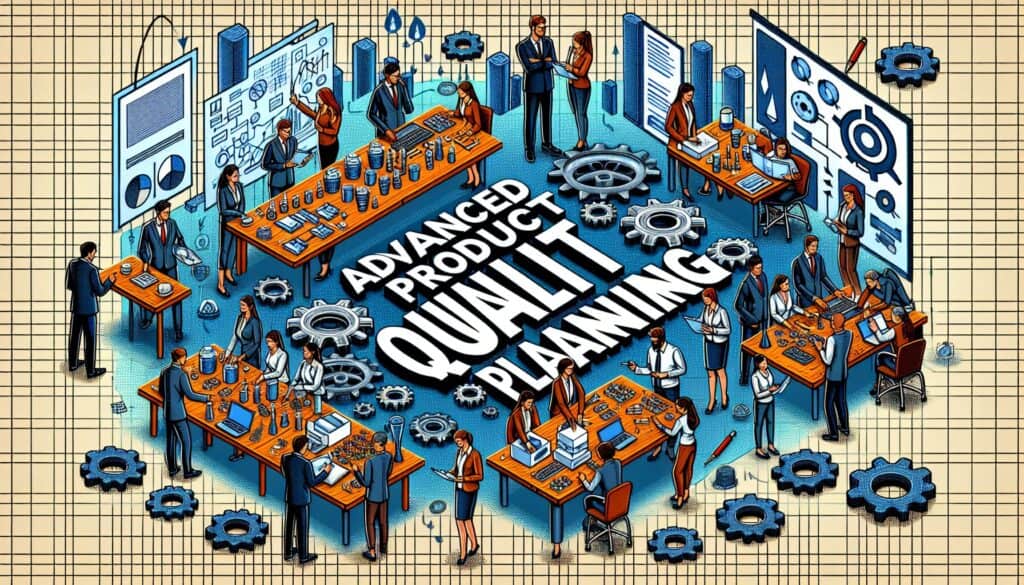A structured process that defines and establishes the steps necessary to ensure that a product satisfies the customer’s requirements and expectations, on time and at an acceptable cost.
- Méthodologies : Clients et marketing, Idéation, Conception de Produits
Planification avancée de la qualité des produits (APQP)

Planification avancée de la qualité des produits (APQP)
- Planification avancée de la qualité des produits (APQP), Amélioration des processus, Développement de produits, Gestion du cycle de vie des produits, Assurance qualité, Contrôle de qualité, Gestion de la qualité, Système de gestion de la qualité (SMQ), Gestion des risques
Objectif :
Comment il est utilisé :
- A cross-functional team follows a phased approach (typically 5 phases: Plan & Define; Product Design & Development; Process Design & Development; Product & Process Validation; Feedback, Assessment & Corrective Action) using various quality tools to develop and launch new products or processes.
Avantages
- Ensures early identification and mitigation of risks; Promotes collaboration between suppliers and customers; Leads to smoother product launches with fewer problems; Focuses on meeting customer requirements throughout the product lifecycle.
Inconvénients
- Can be a lengthy and document-intensive process; Requires significant upfront planning and resources; Effectiveness depends on active participation from all stakeholders and strong project management.
Catégories :
- Fabrication, Conception de Produits, Gestion de projet, Qualité, Gestion des risques
Idéal pour :
- Developing and launching new products or making significant changes to existing products/processes, particularly in the automotive and other manufacturing industries, to ensure quality and customer satisfaction.
Advanced Product Quality Planning (APQP) is particularly beneficial in industries where product reliability and compliance with safety standards are paramount, such as automotive manufacturing, aerospace, electronics, and medical devices. As teams embark on this structured framework, they can effectively incorporate various quality tools such as Failure Mode and Effects Analysis (FMEA), Revues de conception, and Control Plans at each phase, which ensures that potential issues are addressed well before reaching the consumer market. Companies like Ford, General Motors, and Toyota have successfully implemented APQP to not only enhance their product development cycles but also to strengthen relationships with suppliers by involving them in early discussions, which leads to better integration of materials and processes. One of the key contexts for APQP is during the initial stages of a project, where cross-functional teams consisting of design engineers, quality assurance personnel, marketing representatives, and manufacturing experts converge to define project specifications. The involvement of diverse stakeholders fosters a comprehensive understanding of customer requirements and regulatory standards, ensuring that all voices are heard in the design and development phases. As product and process validation unfolds, rigorous testing and inspections occur, enabling organizations to verify product conformance against defined quality benchmarks. In the feedback phase, retrospective assessments are conducted, allowing teams to learn from the launch experience, capture lessons learned, and implement corrective actions for future projects. This holistic approach not only mitigates risks associated with product failures but also boosts customer satisfaction through improved product quality and reliability, thereby enhancing the overall brand reputation in competitive markets.
Principales étapes de cette méthodologie
- Identify customer needs and expectations.
- Develop product concepts and define preliminary requirements.
- Create detailed design and engineering specifications.
- Establish process flow and develop manufacturing plans.
- Conduct validation tests and reliability assessments.
- Implement feedback mechanisms for continuous improvement.
Conseils de pro
- Integrate advanced simulation tools in the Design & Development phase to predict product performance and identify potential design flaws early.- Implement iterative feedback loops with robust metrics during Product & Process Validation to refine processes and align with evolving customer needs.- Utilize cross-functional workshops to enhance supplier collaboration, ensuring alignment on quality standards and expectations throughout the APQP phases.
Lire et comparer plusieurs méthodologies, nous recommandons le
> Référentiel méthodologique étendu <
ainsi que plus de 400 autres méthodologies.
Vos commentaires sur cette méthodologie ou des informations supplémentaires sont les bienvenus sur le site web de la Commission européenne. section des commentaires ci-dessous ↓ , ainsi que toute idée ou lien en rapport avec l'ingénierie.
Contexte historique
1962
1970
1972
1980
1980
1986
1986
1960
1963
1970
1980
1980
1980
1986
1987
(si la date est inconnue ou n'est pas pertinente, par exemple "mécanique des fluides", une estimation arrondie de son émergence notable est fournie)















Articles Similaires
Questionnaires sur les troubles musculo-squelettiques
Tests à plusieurs variables (MVT)
Analyse de régression multiple
Systèmes de capture de mouvement
Méthode MoSCoW
Test de la médiane de Mood